
The Dolomites have a somewhat fearsome reputation when it comes to trad climbing and when viewing the peaks with their characteristically steep faces it is easy to see why. There are however plenty of easy routes to go at in terms of technical difficulty, just bearing in mind that7 pitches is a relatively short route and many of the descents require multiple abseils.
Its always hard to put together a best of list, not only because it is so subjective but also because there are simply so many good routes to choose from.Nevertherless here arefive'recommended' routes of varying lengths that devolop at a relatively amenable grade. For general and logistical information see the Dolomites destination article.
Just remember to start small and early...
Sass Pordoi - Fedele (IV+) into Dibona (IV+) - 24 pitches total
The huge Northwest Face of Sass Pordoi is one of the largest and most impressive in the Dolomites. The dark and smooth-looking face is intimidating on first (and indeed subsequent) viewings; which makes it all the more amazing that the classic Fedele route goes at a relatively amenable IV+. The climb weaves its way along the edges of the large black water steak that dominates the central wall. This constant trickle of water has scrubbed the rock clean and sculpted a veritable jug ladder up the steep face. As you might expect, it is advisable to wait for a dry period to tackle this beautiful climb. The route crosses the black steak several times, most infamously on pitch 14, which is usually soaking at best and an impassable waterfall at worst. The terrace at three-quarters height provides a possible escape for those pressed for time.
For those up to the challenge the Dibona Upper Wall provides the logical continuation and is highly recommended. Combining the routes gives almost a kilometre of climbing up one of the most impressive faces of the Dolomites whilst never exceeding upper grade IV.
Sas Ciampac - Adang/Old South Face (V-) -11 pitches
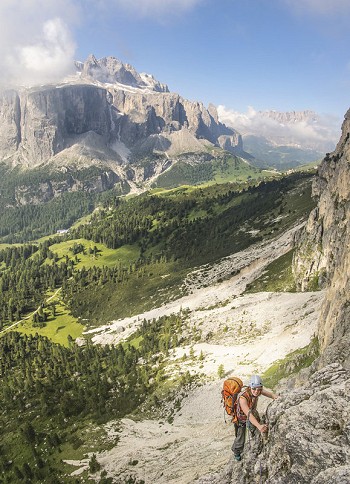
© James Rushforth |
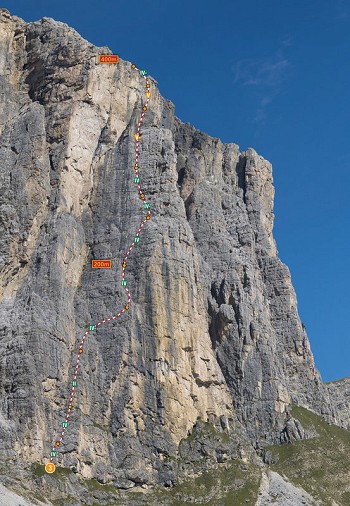
© James Rushforth |
The impressive and sunny south face of Sas Ciampac is a familiar sight to anyone descending the Gardena Pass towards Corvara. Situated just west of the elegant Sassongher, and rising out of beautiful flower meadows, the location is nothing short of idyllic. The Adang/Old South Face follows a huge rightwards trending black slab before taking a series of chimneys up to the panoramic summit plateau. The climbing is superb throughout with no polish and good clean rock, albeit with slightly difficult route finding up the initial slabs. The hour long walk in ensures solitude is usually the norm and the views over to the Sella are excellent. Finally the descent is uncomplicated, following the very scenic path 2 towards Passo di Crespina and then down to Jimmy's Hutte for a well deserved beer.
Torre Delago - Piaz Arete/Delagokante (IV+) - 6 pitches
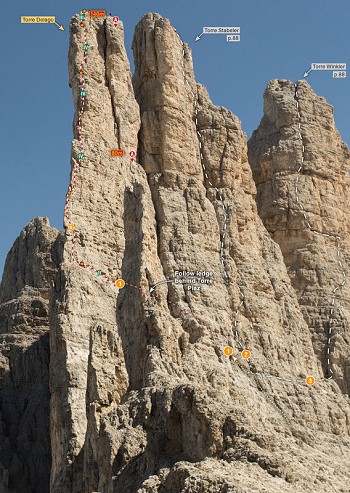
The Vajolet Towers have long symbolised the Catinaccio (Rosengarten) group and viewed from Rifugio Re Alberto (Gartlhtte) the trio of towers are an impressive sight. However the true cause for their fame becomes immediately apparent when first stepping on to the arete of the classic Piaz Arete/Delagokante. The ground suddenly plunges down some 500m to the valley bottom creating some of the best exposure found anywhere in the world at the grade. Despite the queues and the polish, there is no doubt that this route deserves its acclaim, with fantastic positions and breathtaking exposure at an accessible grade.
Torre Delago was also used in the now infamous opening scene of Sylvester Stallone's 'Cliffhanger'.
Tre Cime -Cima Grande - DibonaArete(IV+) - 13 pitches
Cima Grande is the largest of the three towers that make up the icon Tre Cime group, and its north side makes up one of the prestigious six classic north faces of the Alps. This popular climbprovides one of the easiest routesto the summit of Cima Grande which is a much sought aftertick for many. Route finding is difficult and there is certainly a degreeof 'following your nose' as there areso many possible lines. This only serves to heighten the sense of adventure however, which is ultimately what aroute of this nature isall about.
It is usual to join onto the Normal Route from the ringband terrace to reach the summit, an experience which definentelyshouldn't be shunned due to the spectacular views from the top.
Sass de Stria/Hexenstein - South Arete (IV+) - 8 pitches

Sass de Stria or the witches rock is an iconic peak located at the junction of the Falzarego and Valparola Passes, its dominating stand-alone position compensating for its relatively low altitude. The prominent South Arete provides a deservedly popular route of modest length that is the perfect introduction to Dolomite trad. The rock is mainly solid and, although not always logical, the route is varied and enjoyable. There are cemented belays throughout, but scant fixed gear en-route so take a decent rack. The hardest bit comes at the end and can be avoided to the right if you'refeeling unsure, though you should give it a crack as its probably the best pitch. The descent is once again uncomplicated following a protected path through World War One trenches back down to the Valparola pass.
Logistics
When to Go
Though it is possible to complete climbs during the winter months (some of the via ferrata make for excellent ski tours) generally speaking the best season runs from June to the start of October. However at the beginning of the season there is often still a lot of snow about and it is usually necessary to seek lower altitude south facing routes.
Lifts
Most of the lifts open around the third week of June and close in mid September, but it is worth contacting the local tourist offices for exact information if you are planning on using specific lifts during your trip.
How to Get There
The Dolomites are easily accessible from three airports all a similar distance away. Innsbruck is the closest airport within 2 hours driving distance of the Sella over the Brenner Pass. Cars can be hired from the airport from a number of different companies. Venice Marco Polo is the other main airport within 2 and a half hours drive from the Sella. There are again a number of car hire companies. Alternatively there are several public transport options from Venice; a direct bus runs throughout high season from Venice to the villages surrounding the Sella, or alternatively a more frequent train service runs to Belluno, from where it is then possible to catch a number of buses.
Treviso airport though only small is actually 15 minutes closer than Venice if you can get a flight there. Public transport is available to the centre of Treviso or into Venice, and then you can take a train / bus as above.
Alternatively it is possible to drive from the UK via Germany and Belgium before approaching the Dolomites from the North entering at Pedraces (recently renamed Badia). I usually stay in a hotel near Munich and do the trip in two days.
Hire cars are expensive, around £150 per week. BMC members can get a discount through Hertz.
Accommodation Advertise here
No Premier Listings found in this area
The towns of Arabba, Canazei, Cortina, Corvara, Colfasco, La Ville, Pedraces and Selva are all good locations from which to reach the popular climbing areas. Camping is available in both Colfosco, Cortina and Canazei, and hotels can be found in all of the towns. UKC regular Mike Kann is very knowledgeable about the area and runs a nice set of apartments (Casa-Alfredino) near the Marmolada.
Gear
There are a lot of outdoor shops in any decent sized town. The best are:
Sportler - Treviso - A huge complex and only 2km from the airport there.
K2 - Cortina - A small but fantastic gear shop.
Sport Amplatz - Canazei - One of the best shops in the area.
Sport Kostner - Corvara - A good shop with attatched super-market.
Outdoor Shops Advertise here
No Premier Listings found in this area
Instructor/Guides Advertise here
No Premier Listings found in this area
Other Activities
There is climbing and walking, the zipwire at Kronplatz (supposed to be the longest in Europe), a high ropes course at Colfosco, horse riding is becoming increasingly popular, as is mountain biking, there is also white water rafting at Brunico, canyoning at Cortina.
Road biking has long been an integral part of the Dolomite mountains and numerous prestigious races take place up the winding and tortuous passes. Apart from the Giro d'Italia, which usually passes through parts of the Dolomites and in particular often features a famous stage by the Tre Cime, the Sella Ronda and the Maratona dles Dolomites see thousands of cyclists taking to the passes.
Wet Weather Options
One of the most relaxing wet weather options is taking advantage of the many spa facilities in the boutique hotels. Many of these are open to non-residents and are an indulgent way to rest aching muscles and generally get pampered.
There are numerous cultural options with excellent museums such as the Messner Mountain Museum in Brunico, the South Tyrolean Museum of Archeology - home of Otzi the ice man - in Bolzano, and the two Ladin museums in San Martino in Badia and San Cassiano. The three Regole di Cortina museums - Paleontology, Ethnography and Modern Art - offer interesting insights into the history of the rocks themselves and the heritage of the people who lived around them.
Anyone with an interest in more recent history may be interested in the First World War Museum at the Tre Sassi Fort on the Valparola Pass or at the Marmolada mid station.
JamesRushforth has just completed the new Rockfax guide - The Dolomites : Rock Climbs and Via Ferrata and is currently working on another guide toItalian sport-climbing destination Finale Ligure.
James Rushforth is a professional photographer and you can see his portfolio on Smugmug, and follow him at JamesRushforth.com
- DESTINATION GUIDE: The Dolomites - Via Ferrata 12 Jul, 2015
- Dolomites - Ski Mountaineering and Snowshoeing 26 Mar, 2015
- CAPTURING THE STARS: Night Sky Photography 16 Oct, 2014
- DESTINATION GUIDE: Dolomites - Ice, Mixed and Drytooling 22 Mar, 2012
- DESTINATION GUIDE: The Dolomites 22 Apr, 2010
- Climbing the Comici - VII / E3 5c, Dolomites 21 Apr, 2010





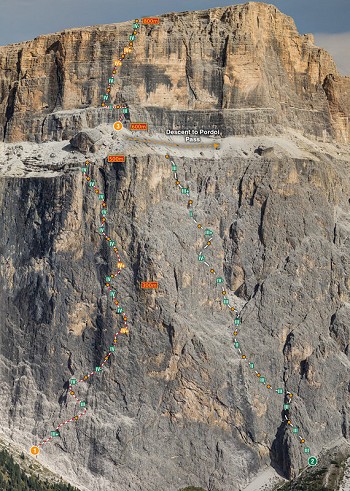


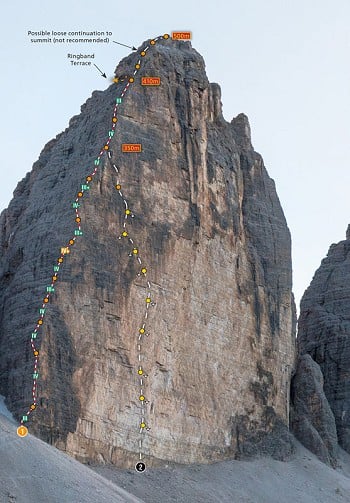
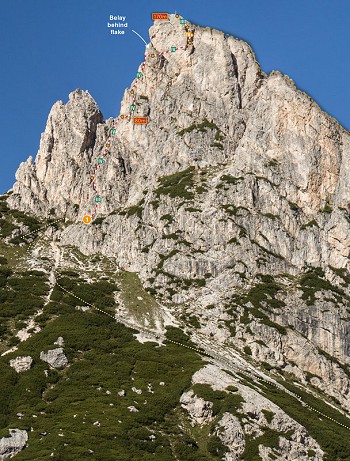

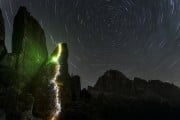

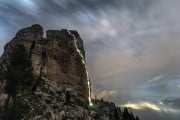
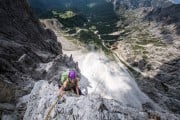

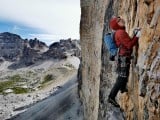


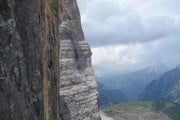









Comments